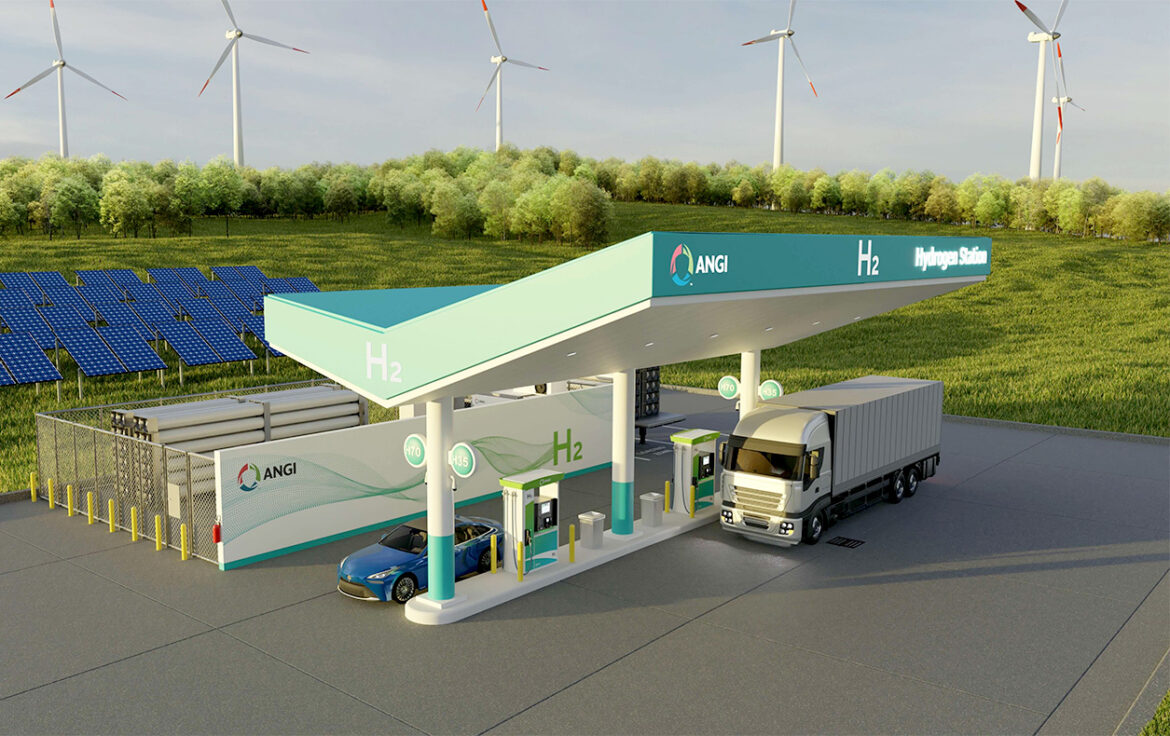JANESVILLE, Wisconsin, 19th January 2024 – ANGI Energy Systems (‘ANGI’), a Vontier (NYSE: VNT) company and leading global provider of critical technologies and solutions to decarbonize the mobility ecosystem looks back at 2023, the year hydrogen fuel for heavy transport gathered momentum. The hydrogen industry is undergoing a transformative journey driven by the immense potential of hydrogen as a clean, efficient, and versatile energy carrier. This journey is set to revolutionize the global energy landscape, paving the way for a sustainable and low-carbon future. From the surge in hydrogen-powered vehicles coming to market and the advent of innovative infrastructure to solve near-term needs to the rising tide of green hydrogen, here are ANGI’s top 10 insights on the trends that have shaped the hydrogen narrative this year.
1. Mobile Fuel Stations: Innovative Solutions Bridging Infrastructure Gaps
ANGI has conducted an analysis indicating that a minimum of 1,000 hydrogen refueling stations is necessary across the United States and Europe to effectively meet the growing demand for hydrogen fuel. This translates to the establishment of a refueling station approximately every 186 miles or 300 kilometers along major routes. Addressing the inherent challenge of the chicken-and-egg scenario, where the development of vehicles and infrastructure is interdependent, the company proposes a strategic approach by utilizing mobile refuelers while waiting for fixed infrastructure to attain the required density. This interim solution allows for the transportation of hydrogen fuel to locations where it is needed, thereby instilling confidence and expediting the adoption of hydrogen vehicles by original equipment manufacturers (OEMs).
In collaboration with key partners, ANGI Energy is actively addressing the challenges associated with the lag in fixed infrastructure development. The company emphasizes that mobile refuelers offer a flexible and efficient bridge to overcome this gap. By providing a viable solution, these mobile units empower vehicle manufacturers and early adopters of hydrogen fleets to assess the technology’s feasibility, even in regions where fixed infrastructure is not yet at scale.
2. Green Hydrogen Takes Center Stage
The push for sustainable energy solutions has intensified, with green hydrogen receiving serious attention and increasing investment. Harnessing renewable energy sources, volume production of green hydrogen has gained traction. We are starting to witness a noticeable shift from small-scale on-site hydrogen production to larger-scale facilities, where hydrogen is then transported to sites via tube trailers or pipelines. The strategic placement of these production facilities in clean energy areas is instrumental in propelling the growth of green hydrogen usage.
Whilst the green hydrogen economy is crucial for a low carbon energy future, particularly for hard to abate sectors like industry and transportation, ANGI advocates for a balanced approach to what has often been dubbed the blue vs. green hydrogen debate. Recognizing the role of blue hydrogen, produced through a process involving natural gas with carbon capture and storage, as an interim solution is a pragmatic step toward a future dominated by green hydrogen.
3. OEM Activity On The Rise
In 2023, vehicle manufacturers (‘OEMs’) in the heavy transport sector spearheaded the hydrogen industry’s growth through increased OEM activity. This involved strategic partnerships, technological advancements, and the development of numerous purpose-built hydrogen vehicles, ranging from buses to trucks and construction vehicles. Major OEMs, including Toyota, GM, and Ford, redirected their focus, exemplified by Toyota shifting from passenger vehicles to prioritizing commercial pick-ups and heavy transport. This collective shift, coupled with a growing interest from more conservative industries such as professional motorsport not only validates hydrogen technology’s viability but also ensures a diverse and competitive market. This dynamic environment fosters innovation and propels demand within the industry.
4. Uptime Is Key To Confident Adoption
ANGI’s customer outreach has highlighted the importance of uptime and performance guarantees. With hydrogen stations expected to be around 300km apart initially, station downtime simply cannot be an option and is understandably a major concern for station owners and drivers alike. Customers’ first experiences with hydrogen refueling need to align with their expectations from other fuel types, otherwise they may become discouraged and it could be their last foray into hydrogen. ANGI’s hydrogen solution leverages over 40 years’ experience in compressed gases, complemented by 150+ years of retail fueling technology expertise from their sister company, Gilbarco Veeder-Root. The company strongly acknowledges the significance of station uptime for customers and has developed a robust, proven service offering to prevent unnecessary downtime.
5. Funding: Less Talk And More Action
The hydrogen industry is attracting significant investment from governments on both sides of the Atlantic. In the US both the Inflation Reduction Act and Bipartisan Infrastructure Law, and in Europe the Hydrogen Bank have been established to help speed up and de-risk projects. However, industry observers have seen that money is slow to flow, and whilst funding has been announced for the seven hydrogen hubs in the US, many projects are still at the planning stage.
6. Awareness Is On The Rise, But There Are Still Myths To Dispel
Whilst references to hydrogen are increasing in the everyday vernacular, as demonstrated by a 65% increase in hydrogen related Google searches over the last five years, there are still many misconceptions around hydrogen, dispenser technology and hydrogen filling stations as they are still largely “pre-market”. ANGI is dispelling the myths around safety, gathering data, educating the market and showcasing best practice with the establishment of two key hydrogen engineering centers of excellence, based in Wisconsin, US and also Salzkotten, Germany. ANGI recognizes that there are complexities to station design and infrastructure, and its Hydrogen Refueling Stations are designed for optimal uptime whilst offering a familiar refueling experience to the user. Awareness and education will be key to support widescale deployment of hydrogen refueling infrastructure across the US, EU and beyond.
7. Forecasting Demand Continues To Be A Challenge
In the nascent stages of the hydrogen industry, anticipating the growth of demand over the next two, five, and ten years is crucial for informed decision-making. This understanding serves as a key factor in determining station capacity and scaling requirements to meet the expanding market. Companies like ANGI are making substantial investments in hydrogen based on thorough customer research and strategic planning. Despite these educated assumptions, uncertainties persist. Unlike with traditional fuels and Internal Combustion Engine (ICE) vehicles with well-established demand profiles, ANGI is leveraging Artificial Intelligence and simulations to develop robust models for future hydrogen demand. This includes considerations such as the hydrogen source, delivery methods, fueling frequency, and pressure levels (350 or 700 Bar).
8. The Need For Hydrogen Industry Self-Promotion
Hydrogen has a key role to play in delivering a zero-emission future due to its rapid refueling and suitability for heavy-duty transport. Increased visibility in the mainstream media and with hydrogen powered transport on the public roads will not only attract investments and partnerships but also foster public awareness and support for hydrogen’s essential role in our sustainable energy landscape. It’s time for the hydrogen sector to step into the spotlight and showcase its potential to shape a cleaner, greener future.
9. Collaborations And Partnerships Are Key
To expedite industry scalability, ANGI sees great value in forming both consortiums and partnerships for the nascent hydrogen sector. Consortiums can engage together on funding research and development projects, advocating for supportive policies and regulations, creating standards, and market development. They can be both regional, like the California Hydrogen Business Council, national, like the Fuel Cell and Hydrogen Energy Association, and global such as the Hydrogen Council.
Technology partnerships in the hydrogen industry involve collaborations between companies and organizations to develop, enhance, or deploy hydrogen-related technologies. Sucessful examples of these include Plug Power and Amazon partnering on green hydrogen production to fuel Amazon’s forklifts. Toyota and BMW have collaborated on the development of fuel cell technology to accelerate the roll out of hydrogen powered vehicles and share expertise to overcome challenges. This trend for collaboration signifies a collective push to foster synergies that positively impact the entire hydrogen value chain.
10. International Collaboration For Global Hydrogen Standards
Recognizing the global nature of the hydrogen industry, international collaboration for the development of standardized protocols and regulations has gained prominence. Efforts are underway to establish common standards for hydrogen production, transportation, and utilization, ensuring seamless interoperability and fostering a cohesive global hydrogen market. This collaborative approach is essential for overcoming regulatory barriers and creating a level playing field for stakeholders worldwide.
In summary, 2023 marked a pivotal year for hydrogen mobility, witnessing great progress throughout the hydrogen value chain, from innovations in production, new refueling technology and the development of vehicles powered by both fuel cells and hydrogen combustion by major OEMs. Leveraging over 40 years of expertise in compressed gases for transportation, ANGI is committed to advancing the industry by upholding best practices, fostering innovation, facilitating the deployment of hydrogen fleets, and establishing key partnerships with technology providers. The company’s dedication aims to sustain momentum in 2024 and drive towards a low-carbon future.








